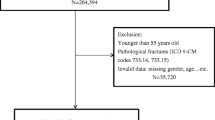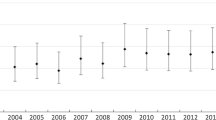Abstract
Declining incidences of hip fractures are reported from western countries. Norway has among the highest rates in the world. The aim of this study was to investigate trends in total hip fracture rates in Norway between 1999 and 2008 and risk of second hip fractures. All hospitalizations given a hip fracture diagnosis code (International Classification of Diseases (ICD) 9 or ICD 10) (cervical, trochanteric or subtrochanteric) in Norwegian hospitals were retrieved with accompanying surgical procedure codes and additional diagnoses. A total of 93,123 hip fractures were identified between 1999 and 2008 in persons ≥50 years. Annual incidences of hip fractures were calculated and tested for trends. Rates of first and second hip fractures (2006–2008) were compared. The age-standardized total incidence of hip fracture decreased by 13.4 % (95 % confidence interval (CI): 11.0–15.6) in women and 4.8 % (95 % CI: 0.7, 8.7) in men. Age-adjusted rates of second hip fractures did not change in the observation period. In those with a prior hip fracture, the age-standardized risk of a subsequent hip fracture was 2.5-fold (95 % CI: 2.5, 2.6) in women, and 4.6-fold (95 % CI: 4.5, 4.7) in men. Total hip fracture rates declined in both genders during 1999–2008, whereas rates of second hip fractures did not change.


Similar content being viewed by others
References
Johnell O, Kanis J. Epidemiology of osteoporotic fractures. Osteoporos Int. 2005;16(Suppl 2):S3–7.
Johnell O, Kanis JA. An estimate of the worldwide prevalence and disability associated with osteoporotic fractures. Osteoporos Int. 2006;17:1726–33.
Cooper C, Cole ZA, Holroyd CR, et al. Secular trends in the incidence of hip and other osteoporotic fractures. Osteoporos Int. 2011;22:1277–88.
Kannus P, Niemi S, Parkkari J, et al. Nationwide decline in incidence of hip fracture. J Bone Miner Res. 2006;21:1836–8.
Leslie WD, O’Donnell S, Jean S, et al. Trends in hip fracture rates in Canada. JAMA. 2009;302:883–9.
Brauer CA, Coca-Perraillon M, Cutler DM, et al. Incidence and mortality of hip fractures in the United States. JAMA. 2009;302:1573–9.
Abrahamsen B, Vestergaard P. Declining incidence of hip fractures and the extent of use of anti-osteoporotic therapy in Denmark 1997–2006. Osteoporos Int. 2010;21:373–80.
Maravic M, Taupin P, Landais P, et al. Change in hip fracture incidence over the last 6 years in France. Osteoporos Int. 2011;22:797–801.
Hartholt KA, Oudshoorn C, Zielinski SM, et al. The epidemic of hip fractures: are we on the right track? PLoS One. 2011;6:e22227.
Adams AL, Shi J, Takayanagi M, et al. Ten-year hip fracture incidence rate trends in a large California population, 1997–2006. [published online ahead of print February 21, 2012] Osteoporos Int 2012. doi:10.1007/s00198-012-1938-5.
Finsen VV. Hip fracture incidence in central Norway: a followup study. Clin Orthop Rel Res 2004;(419):173–178.
Bjorgul K, Reikeras O. Incidence of hip fracture in southeastern Norway: a study of 1,730 cervical and trochanteric fractures. Int Orthop. 2007;31:665–9.
Lofthus CM, Osnes EK, Falch JA, et al. Epidemiology of hip fractures in Oslo, Norway. Bone. 2001;29:413–8.
Stoen RO, Nordsletten L, Meyer HE, et al. Hip fracture incidence is decreasing in the high incidence area of Oslo, Norway. [Published online ahead of print January 14, 2012] Osteoporos Int 2012. doi: 10.1007/s00198-011-1888-3.
Kanis JA, Johnell O, De Laet C, et al. A meta-analysis of previous fracture and subsequent fracture risk. Bone. 2004;35:375–82.
Center JR, Bliuc D, Nguyen TV, et al. Risk of subsequent fracture after low-trauma fracture in men and women. JAMA. 2007;297:387–94.
Melton LJ III, Kearns AE, Atkinson EJ, et al. Secular trends in hip fracture incidence and recurrence. Osteoporos Int. 2009;20:687–94.
Ryg J, Rejnmark L, Overgaard S, et al. Hip fracture patients at risk of second hip fracture: a nationwide population-based cohort study of 169,145 cases during 1977–2001. J Bone Miner Res. 2009;24:1299–307.
Hagino H, Sawaguchi T, Endo N, et al. The risk of a second hip fracture in patients after their first hip fracture. Calcif Tissue Int. 2012;90:14–21.
StatBank Norway. 2012. http://statbank.ssb.no//statistikkbanken/default_fr.asp?PLanguage=1. Accessed 23 Feb 2012.
Alvaer K, Meyer HE, Falch JA, et al. Outdoor air pollution and bone mineral density in elderly men—the Oslo health study. Osteoporos Int. 2007;18:1669–74.
Joakimsen RM, Fonnebo V, Sogaard AJ, et al. The Tromso study: registration of fractures, how good are self-reports, a computerized radiographic register and a discharge register? Osteoporos Int. 2001;12:1001–5.
Dimai HP, Svedbom A, Fahrleitner-Pammer A, et al. Epidemiology of hip fractures in Austria: evidence for a change in the secular trend. Osteoporos Int 2011; 22:685–692.
De Laet C, Kanis JA, Oden A, et al. Body mass index as a predictor of fracture risk: a meta-analysis. Osteoporos Int. 2005;16:1330–8.
Meyer HE, Tverdal A. Development of body weight in the Norwegian population. Prostaglandins Leukot Essent Fatty Acids. 2005;73:3–7.
Droyvold WB, Nilsen TI, Kruger O, et al. Change in height, weight and body mass index: longitudinal data from the HUNT Study in Norway. Int J Obes (Lond). 2006;30:935–9.
Midthjell K. Public health development. The HUNT study, Norway. HUNT1 (1984–1986)—HUNT 2 (1995–1997)—HUNT 3 (2006–2008). 2011;60–64. http://www.ntnu.no/documents/10304/1130562/folkehelse-i-endring-huntrapport-2011.pdf.
Fisher AA, O’Brien ED, Davis MW. Trends in hip fracture epidemiology in Australia: possible impact of bisphosphonates and hormone replacement therapy. Bone. 2009;45:246–53.
Meyer HE, Lofthus CM, Sogaard AJ, et al. Change in the use of hormone replacement therapy and the incidence of fracture in Oslo. Osteoporos Int. 2009;20:827–30.
StatBank Norway. Percentage daily smokers and occasional smokers, by sex and age. http://statbank.ssb.no/statistikkbanken/Default_FR.asp?PXSid=0&nvl=true&PLanguage=1&tilside=selecttable/hovedtabellHjem.asp&KortnavnWeb=royk. Accessed 23 Feb 2012.
Kanis JA, Johnell O, Oden A, et al. Smoking and fracture risk: a meta-analysis. Osteoporos Int. 2005;16:155–62.
van Geel TA, Huntjens KM, van den Bergh JP, et al. Timing of subsequent fractures after an initial fracture. Curr Osteoporos Rep. 2010;8:118–22.
Acknowledgments
The authors are deeply grateful to system architect monitoring Tomislav Dimoski at The Norwegian Knowledge Centre for the Health Services who developed the system that enabled extraction and transfer of data from PAS. He and his team also carried through the collection of the hip fracture data. Senior advisor Dominic Hoff at the Norwegian Institute of Public Health helped with data processing. The authors thank the staff at the Department of Pharmacoepidemiology (Norwegian Institute of Public Health), and Sverre Bjarte Johnsen (Statistics Norway) for assisting in transferring the data to the Norwegian Institute of Public Health and in the encryption process. Hip fracture data for validation of the NOREPOS Hip Fracture Database were obtained from local fracture registries in Tromsø and Oslo, and the authors thank the study investigators for their permission to use these data. This study was supported by a grant from the Research Council of Norway.
Conflict of interest
The authors declare that they have no conflict of interest.
Author information
Authors and Affiliations
Corresponding author
Additional information
NOREPOS (The NORwegian EPidemiologic Osteoporosis Studies) is a collaboration between epidemiologic osteoporosis studies, which are sub-studies within large population-based surveys in four districts of Norway (Tromsø, Nord-Trøndelag, Hordaland, Oslo). The NOREPOS Hip fracture Database includes all hospitalizations for hip fracture in Norway.
Electronic supplementary material
Below is the link to the electronic supplementary material.
10654_2012_9711_MOESM1_ESM.doc
Supplementary table Total number of hip fractures1999–2008 in five year age groups in women and men. The NOREPOS Hip Fracture Database 1999–2008 (DOC 35 kb)
Rights and permissions
About this article
Cite this article
Omsland, T.K., Holvik, K., Meyer, H.E. et al. Hip fractures in Norway 1999–2008: time trends in total incidence and second hip fracture rates. A NOREPOS study. Eur J Epidemiol 27, 807–814 (2012). https://doi.org/10.1007/s10654-012-9711-9
Received:
Accepted:
Published:
Issue Date:
DOI: https://doi.org/10.1007/s10654-012-9711-9




